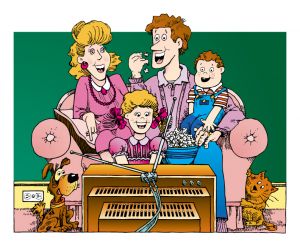By Joanna Glass, leader of API of Garner, North Carolina
Editor’s Note: This Letter to the Editor was written in response to an article published on The Attached Family on July 28, 2009, “TV as a Teaching Tool?” The topics on The Attached Family are open for discussion, and readers are welcome to write articles in response to any of the articles published in this ezine. Attachment Parenting International will clarify any points related specifically to the Eight Principles of Parenting; but with topics that do not fall directly under the Eight Principles, we aim to foster a healthy discussion of ways that parents can strengthen their attachment with their child. To submit a response for publication, e-mail editor@attachmentparenting.org.
response to an article published on The Attached Family on July 28, 2009, “TV as a Teaching Tool?” The topics on The Attached Family are open for discussion, and readers are welcome to write articles in response to any of the articles published in this ezine. Attachment Parenting International will clarify any points related specifically to the Eight Principles of Parenting; but with topics that do not fall directly under the Eight Principles, we aim to foster a healthy discussion of ways that parents can strengthen their attachment with their child. To submit a response for publication, e-mail editor@attachmentparenting.org.
We all hear the negative about television. Television is associated with obesity, sleep problems, Attention Deficit Disorder (ADD) and Attention Deficit Hyperactivity Disorder (ADHD), violent behavior, and poor school performance. Is there truth to it? Should we blame our problems on electronic media?
Author’s Note: I wrote to my fellow leaders and to API Headquarters asking about this issue and approached them with some of my feelings about what I have learned over the years. They were very open and receptive to hearing some of the alternatives to some of the negative information that is being brought up about this subject, so I wrote this article. It is a bit longer than I planned. The wonderful view of API is that families of varying beliefs can participate. It is open to everyone. It is an online community that has not created a homophily atmosphere, which has begun to plagues so many other sites and groups.
API groups and forums leave so much room for diversity, and with diversity, we have room to grow as people and as parents. If we homogenize everything and only associate with parents who believe the same thing, we are only hurting ourselves and our children, for our children are not us, they are their own person who craves exposure to new information.
ADD and ADHD
The information that the American Academy of Pedatrics based their statement on was shown not to be factual. This information can be obtained directly from the ADHD sites and the author of the “study” himself.
Dimitri Christakis, MD, an associate professor of pediatrics at the University of Washington and co-director of the school’s Institute for Child Health, admits that his study was limited. He based his research on a previous survey of about 1,300 mothers who recalled the television habits of their children in early childhood. Such after-the-fact reporting is considered highly fallible, because parents often over- or under-report the amount of TV watched.
What’s more, the study linked TV-viewing to general attention problems rather than to diagnosed ADD. Study participants were never asked whether their children had Attention Deficit Disorder. Instead, the study looked at five kinds of attention difficulties, including “obsessive concerns” and “confusion,” neither of which are core ADD symptoms.
Nor did the study consider the kinds of programs children watched. Educational programs, such as Blue’s Clues or Mr. Rogers, which have a slower pace, rely on storytelling, and avoid rapid zooms, abrupt cuts, and jarring noises, weren’t differentiated from more aggressive programming. Neither did the researchers consider whether TV-viewing and attention difficulties presented a chicken-or-egg situation. According to an article in ADDitude Magazine, “Living Well with ADD and Learning Disabilities,” some critics suggest that younger children with pre-existing attention deficits may be drawn to watching TV, while solving simple puzzles or concentrating on games would be an uphill battle. They add that parents of these children might turn to the TV for relief more frequently than parents of kids who have less trouble staying focused.
Another interesting article about ADD and technology by Joel Spolsky stated: “ADD is often marked by an inability to focus on a given task or, in the case of ADHD, a tendency to hyperfocus and then lose complete focus. Just as with multiple personality, mainstream media has made autism and ADD appear to be commonplace and everywhere.
Technologists have also adopted and promoted these concepts, marking them as valuable to the way of geek life. Many of you are staring at your laptops, multitasking. At computer conferences these days, like the one where this talk was given, it’s not unusual for 80% or 90% of the audience to be using laptops for something during the presentations.”
Our society requires that we be able to not have complete focus at all times. Many parents assume that their child sitting very focused on the television program is a lack of focus, when in fact it is not. We disrupt them and pull them away, which actually creates the problem with paying attention. Just because it may not be something that we are interested in doesn’t mean it is any less important.
Parents will excuse situations by commenting that if it is educational, then it is OK, but as a child who was brought up with this concept, I lacked one most important lesson: The lesson of doing something for the joy of it and because it was what I wanted, something I am learning to do now. For a child, play and joy are the first and most important lessons in life. As a parent, you may not learn something out of watching a children’s program or playing a computer game, but your child may: personal happiness – self happiness that was not created only because you told them it was something they could be happy about. Once I found out how important this was to my child, I found absolute joy in watching and participating with their digital life. I don’t always get it, but what I get is a connection and a bond with my child. They know I trust them enough to find their path and their own joy and that it doesn’t impact my personal beliefs or make either of us wrong.
Violence
Television does not promote violence. Children watching violent programs without their parents taking the time to explain things to them can create situations where violence can occur.
Dozens of books have been written, hundreds of studies published, and hundreds of thousands of invectives thrown by each side towards the other. Despite the extensive research, video games have not been proven to be harmful or to cause violence. The persistence of opponents in trying to pin society’s issues on television and video games is an unfair attempt to demonize a new media for issues that it has not caused.
What makes kids smack others and maybe grow into homicidal adults? Not the tube, says new research, but a lack of social skills – something that television can also provide as an increasing number of families have lost this ability, even down to the basic act of knowing how to invite someone to their home or even how to ready a home for company.
All babies are born with violent tendencies, which most kids learn to control as they grow older, a University of Montreal professor who has spent more than 20 years studying 35,000 Canadian children told ScientificAmerican.com. Those who don’t or can’t learn are the ones who become violent. Author
Richard Tremblay states: “It’s a natural behavior, and it’s surprising that the idea that children and adolescents learn aggression from the media is still relevant. Clearly, youth were violent before television appeared. We’re looking at to what extent the chronically aggressive individuals show differences in terms of gene expressions compared to those on the normal trajectory. The individuals that are chronically aggressive have more genes that are not expressed.” This is an indication “that the problem is at a very basic level,” he added.
A pregnant woman’s smoking, drinking, poor nutrition, or exposure to excessive stress can cause or contribute to a fetus’s abnormal genetic development, Tremblay said. Damaged genes can prevent a child from learning skills for self-expression, reducing his ability to interact socially, and thus make him prone to violence. Tremblay cited genes involved with language acquisition and development as an example; children who can’t speak well get frustrated easily and can erupt violently as a result.
Violence is also passed on. Parents who have violent tendencies pass these along to their children. The prisons are filled with people who were abused as children and grew up to be abusive adults. This is not caused by television but by the lack of intervention and education for families to not use violence as a means to raise their children or solve their problems. We are a country based on fear and violence. We tell our children that we solve our problems by hitting them or hitting each other, and then get upset when they do it and blame television or other media. Violence has been around longer than television.
The Bible has more violence in it than most television programs, and I don’t often hear people saying “close that, turn it off, don’t read that, or you may become violent.” They actually take the time to talk about it with their children.
And I have even seen parents and churches use violence to force belief. It isn’t just the Bible, but all literature. Humans are naturally drawn to violence because we are raised with so much of it. For more information about the history of it and how violence perpetuated in American homes, you may want to read Behind Closed Doors: Violence in the American Family.
Poor School Performance
Poor school performance has been blamed on so many things instead of what it really happening — that the American School systems are failing our children.
Children do not do well in school, because school has become a place where everything is controlled. Instead of children learning naturally and at their own pace, they are forced to learn information that they are not yet interested in or information is being put into them at a pace that they are not able to handle. The hours are too long and the methods being used are cookie-cutter ,not taking into account the individual. Children are being told what they can do from the moment they wake up until the moment they go to sleep. Even the simple act of using the bathroom has become an issue.
Having to ask for permission to use a bathroom is a humiliating and very strange thing to do, something we have gotten use do as adults.
School is a place where all of your rights are stripped when you walk through that door. This isn’t conducive to learning. I have heard parents say that if children had complete control over when they could use the bathroom, there would be chaos. Maybe now there would be, as children have lost the ability to control themselves because we as adults have told them they can’t.
Then there are teachers. Many are not qualified, because it is such a low-paying job. It used to be thought that people would teach because they loved the job, not for the money, but when a family can’t afford to pay their rent, why would they want to teach? So we lose many of the better qualified teachers to jobs that can pay them for that knowledge.
One of the reasons behind our choice to homeschool: My husband worked for the Board of Education on a very high level seeing how those people were paid in excess of over $100 an hour and teachers paid next to nothing and zero money being spent on books. Classrooms were forced to share one book per class of students.
The food in most of our schools is some of the lowest grade food available. We know that healthy foods create a healthier brain and learning environment, but yet we feed our children the lowest quality foods. They have created environments where they have taken disruptive students and children who were not learning well in regular schools and put them into a school where they served healthy organic foods and it was proven a success. The food in our school systems is also another reason why our children are obese, not television.
Parents can do more to make changes in the system. One or two parents may be, but as a community, it is not happening. There are parents who feel they can’t do anything to help, but they can. No matter how small it may seem, everything you do to help your school or community can add to the bigger mixture of everyone else doing something small. Parents can look into charter schools and other educational opportunities for their children. My older children did public school until we moved to where we now live, and then after a year of absolute horror of the public school system here, we opted for charter schools. For our youngest we are homeschooling, actually unschooling.
Some Other Personal Thoughts
Are boundaries an issue or an answer? Are limits? It is more that the parents are not interacting and not discussing with their children what they are viewing and what their feelings are about it. I am not saying a three year old should watch a horror movie, but a teen might want to and wouldn’t it be better for a parent to say learn how to explain these situations to their child instead of him getting that explanation from someone or somewhere else?
I prefer not to dictate what my child watches in bits and pieces. I used to feel that way, and I realized I was not allowing my child to find themselves. I was trying to force them to be clones of myself, something they did not want to be and it caused more problems. For me, this was controlled parenting.
I have seen children crushed by parents because they have told them, this show isn’t good or this part is not good and the child really liked them. They felt crushed, because the parents were disapproving of something they loved.
I have also watched children who have limited TV and the way some parents disrespect their child. They walk up to the television in a middle of a show and turn it off, saying that is enough, choosing what the child’s limits are, telling the child that she is incapable of knowing who she is and what she enjoys. I then have not only witnessed, but have been an unwilling participant in, the child’s outburst.
At more than one play date, the child starting hitting the other children who were allowed to continue watching programs that were playing on a public TV. The parents had set up a hostile angry environment. The parent’s reasoning was she was unable to control herself, so she knew her child would not, either. She had set up a self-fulfilling prophecy that she is passing onto her child. Perhaps the parent had not learned any self control because she never took the time to learn self control. I have also seen parents who fear that their child will become something they do not want them to be or learn that there is a lifestyle different than their own, creating a non-diverse household. Not all of us are supposed to like the same thing. That is why there is so much variety in life.
I had limited my older two children, and it backfired completely, just as every other family I knew who did the same thing had happen. Our children never learned to limit themselves or control themselves. I was always doing the controlling for them – the same way that I and so many others were raised.
With my son Ronnie, I have done the exact opposite. Some days he will watch a couple of hours and some days nothing at all, but I don’t say “no” or comment in any way. He doesn’t have access to violence, but he isn’t interested. He chooses what programs he wants to watch on Noggin and the Public Broadcasting Service, and some of them I may not “get” but he does and that is what is important.
He is not obese, but still, I don’t think the problem with obesity is television. It is lack of activity and lack of affordable activity for most families and so many families not being able to afford better quality foods. I don’t see the community centers like I used to back in New York when my girls were younger. Everything is a paid for activity that most families cannot afford or cannot get to, so children are stuck at home with little to do and with lower grade foods that tend to not build energy and promote activity. The schools have taken away most of the activities, and sports are such an expense for so many families. Not all children are great at soccer, hockey, basketball, and football where the last of the physical activity money is being spent, and most of that is coming from parents who raise funds for them. I would love to see that same passion of fundraising come into play for books. But, back on topic, maybe the schools should have nature hikes each day for an hour, something all students could participate in without feeling inadequate or being forced to compete.
Children who binge-eat are generally from households where control is in every part of their lives, including their choices in food. They never learn to control themselves, and I would like to say from day one, their parents are controlling what they eat when, but it usually starts the moment Mommy stops breastfeeding. That is the point where mothers no longer trust their children and tell them when they are hungry, what they are hungry for, and when they are full. They stop trusting them to know when they are tired and when and where they will sleep. This is very confusing to small children who, up until that point, have been given absolute trust. Just as with adults, for small children, this leads to depression, shame, and guilt, which then can lead to inactivity and overeating and other eating and sleeping disorders and anger.
Blaming television or digital media is easy to do. It is so easy to be anti-something, but being for something and finding real solutions instead of saying “no, don’t do this and don’t do that” would be much more effective.
Commercials and advertisement are important. If we truly do not believe in their use, we have no business using them ourselves. We project our fear of not being able to control ourselves around commercials onto our children.
We, as a society, have no right to dictate what advertisement is okay and which one isn’t. I don’t like fast food, but I have no business telling Sesame Street that they can’t take that grant from McDonald’s because parents are not giving enough to support them.
Or what about TV shows that create toys? They do so for a reason. Children like to identify with their surroundings, and those toys offer this possibility outside the moment they are watching the show. Also, these toys offer employment to the people who make them — in many cases keeping a roof over a family’ head. Not everyone has the luxury of living in a beautiful home being able to sit back and say, “Well, making a toy based on the movie is just consumerism and wrong. Can’t there just be a TV show and a movie without it?”
It may be fine for one family or in reality that one person, but what about what the child wants or another family wants, or the family who is dependent on the income from making that toy. Again, I was anti-toys based on movies, but thankfully my daughter Jackie, now 22 years old, helped me to see the light in the situation: the good that the toy brought to the economy, the jobs it provided throughout the process, and then most importantly, the joy it brought her and her little brother.
Turning off the TV while the commercials while they are on does not teach our children about the commercials and does nothing to change the way they are broadcast. Changing the channel does not either. It just teaches children to turn it off or turn away and do nothing to fix it. Even small children understand more than we give them credit for. If they can understand enough to want something they see on a commercial, why do we deny them an explanation of why commercials exist? At what point do we decide that we are just so much better or smarter than they are and should this be a message we project to our children?
For small children, yes, PBS and commercial-free channels are great, but if you are watching them, then hopefully you are supporting them, even if just a few dollars a year. Living in a commercial-free world has a price, and as parents, we need to be willing to pay for it. I asked more than 70 parents during one of our events last year and not one of them gave to PBS, but all of them watched it. I can’t say I was surprised when I said that our local group was in financial crisis, that no one wanted to help raise funds. There seems to be a disconnect where when people think free, it means it costs nothing. Someone always has to pay.
The problem with keeping the flow with this attraction and not opening our minds to other views and possibilities is that we are cutting ourselves off from reality and diversity.
 One of the hardest situations I face in my household is when one of my children hurts the other one, whether by accident or in play or out of anger. My knee-jerk reaction is to tell the offender to say sorry to her sister, just as my parents had me do when I was younger. My mom would tell me to say sorry and if I did it quickly to get it over with but didn’t really want to say it, she’d say, “Say it like you mean it.”
One of the hardest situations I face in my household is when one of my children hurts the other one, whether by accident or in play or out of anger. My knee-jerk reaction is to tell the offender to say sorry to her sister, just as my parents had me do when I was younger. My mom would tell me to say sorry and if I did it quickly to get it over with but didn’t really want to say it, she’d say, “Say it like you mean it.” response to an article published on The Attached Family on July 28, 2009,
response to an article published on The Attached Family on July 28, 2009,  Editor’s Note: Attachment Parenting International doesn’t take a stance on cell phone use for children and adolescents. This article is to inform parents who do allow cell phone use, or who are considering it.
Editor’s Note: Attachment Parenting International doesn’t take a stance on cell phone use for children and adolescents. This article is to inform parents who do allow cell phone use, or who are considering it. I believe it’s that overall style or pattern of action — rather than a specific decision — that will most affect a child’s behavior. Generally, psychologists have found that there are two main components of parenting styles.
I believe it’s that overall style or pattern of action — rather than a specific decision — that will most affect a child’s behavior. Generally, psychologists have found that there are two main components of parenting styles. Susie Walton used to yell at her kids – a lot.
Susie Walton used to yell at her kids – a lot. Board games, sports, and other competitive activities can bring families closer together as well as teach children important lessons about character. A friend of mine has a nephew who is so unpleasant when he loses, that she refuses to play board games with him anymore. He pounds on the table, calling the other players cheaters or making excuses that it wasn’t his fault he lost the game.
Board games, sports, and other competitive activities can bring families closer together as well as teach children important lessons about character. A friend of mine has a nephew who is so unpleasant when he loses, that she refuses to play board games with him anymore. He pounds on the table, calling the other players cheaters or making excuses that it wasn’t his fault he lost the game. Has your teenager stopped listening to you? Do you routinely catch him telling lies, or does she continually break curfew? You may be finding yourself tempted to make tighter rules and to pass out punishments when these rules are broken. But Christina Botto, author of Help Me with My Teenager!, says this strategy is likely to backfire.
Has your teenager stopped listening to you? Do you routinely catch him telling lies, or does she continually break curfew? You may be finding yourself tempted to make tighter rules and to pass out punishments when these rules are broken. But Christina Botto, author of Help Me with My Teenager!, says this strategy is likely to backfire. Depression is beyond epidemic proportions, not only in the United States but in many societies around the world. People like to blame more recent economic downturns, but these high rates of depression have been an ongoing concern for many years from before the stock markets took a dive.
Depression is beyond epidemic proportions, not only in the United States but in many societies around the world. People like to blame more recent economic downturns, but these high rates of depression have been an ongoing concern for many years from before the stock markets took a dive.